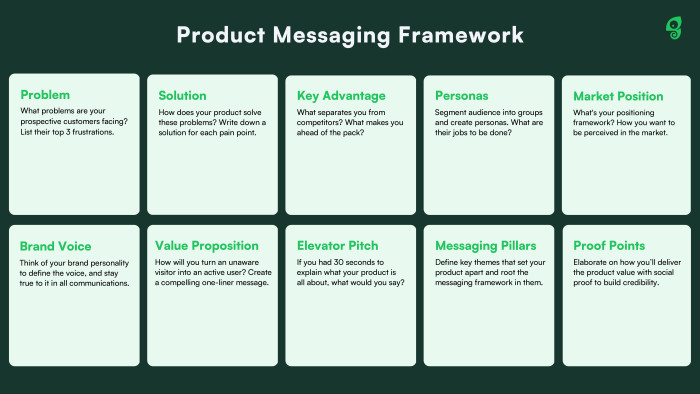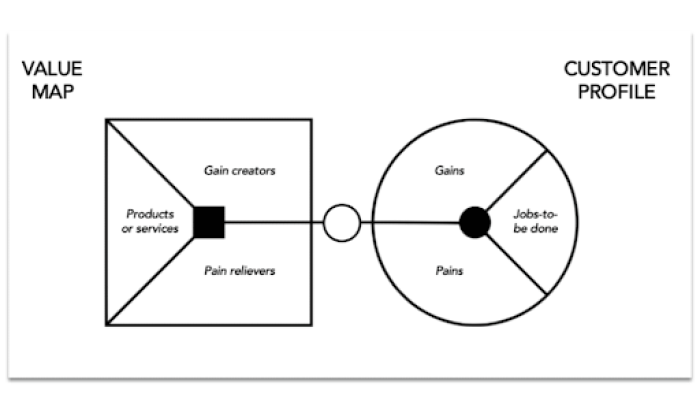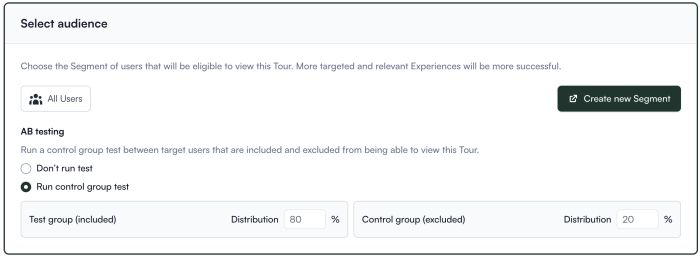What comes to your mind when you hear the term “digital HQ”? Or the phrase “meetings off”? There’s an odd chance you’d guess anything other than Slack and Loom. That’s your quickest lesson on product messaging.
At its core, product messaging creates and reinforces a unique identity for your product. It differentiates you from the crowd, boosts brand recall, and builds your customers’ perception of your product.
It’s why you associate the term “digital HQ” with Slack—because Slack has solidified its position as a digital HQ for many teams through targeted product messaging.
So, let's break down the idea of what a product message is and what you should include in your product marketing framework, complete with examples and a template to help you create your own perfect value proposition.
What is product messaging?
Product messaging defines your product’s value and how you communicate it with potential users.
What makes effective product messaging?
Effective product messaging is about highlighting the product benefits for users in a simple yet differentiated style.
How do you develop messaging for a product?
Successful product messages start from creating your own messaging framework using elements like brand voice, user personas, value propositions, elevator pitches, messaging pillars, and proof points.
To create a messaging framework, start by performing market research to see where you stand currently and identify your ideal customer profile (ICP).
You need a clear value proposition and aligned in-app messaging to stand true to user expectations and succeed with your messaging strategy.
Learn more about how to create product messaging and see great product messaging examples by reading below!
What is product messaging? #
Product messaging is how you communicate your product value to your target audience. It defines how well your prospective users and potential customers understand your product's core functionality and how it helps them solve their pain points.
Product messaging includes all channels of communication—website, in-app messaging, social media, emails, release notes, and more. Put simply, product messaging is everywhere where you communicate and interact with your prospective users and existing customers.
A good example of messaging done right is one of the latest Notion product updates about its AI writing assistant that highlights the company’s messaging style—the message is simple, crisp, and focuses on the main value proposition.
Source: Notion
What does a product messaging framework include? #
You might wonder if product messaging is only about compelling copywriting. The short answer is: No, it goes several steps beyond copywriting.
Elena Madrigal, Director of Product Marketing at GoDaddy, previously at Canva and Microsoft, explains this difference perfectly in her recent post on LinkedIn.
👉 Positioning is a rational appeal to the mind. It’s an expression of WHY our product exists for a specific audience and how we want it to be perceived in the market.
👉 Narrative is an emotional appeal to the heart. It expresses what we stand for and the feelings we want to evoke when people think about our product.
👉 Messaging derives from our positioning. It’s WHAT we say to convey our value. It focuses on the benefits, value, and outcomes that matter most to our target customers.
👉 Copy brings the message to life in an exciting, persuasive, and catchy way. Copy is HOW we communicate our messaging and narrative depending on the channel.
In other words, building a product messaging framework that effectively explains your product features, aligns with your users’ pain points, and influences your target buyers involves multiple parameters.
It includes a thorough examination and brainstorming to answer these five crucial questions:
1. What is your product
Realistically assess your product’s functionality to define what your product can do. Don’t promise users more than what you can deliver. Keep it simple, problem-oriented, and easy to understand.
2. What will you do
Define your core value propositions—what you’ll offer users. Think of this as the after scenario in a before vs. after comparison of your users’ lives. Your value props are directly linked to your product vision and the overarching mission you want to achieve.
3. Why you over others
Identify your primary differentiators in the market. These features set you apart, encouraging people to pick you over your competitors. Your product positioning plays a crucial role in determining the key differentiators for your brand.
4. Why trust you
Build your case to win users’ trust. Establish your credibility through user reviews, media coverage, awards & recognitions, case studies, or brand ambassadors. Add a layer of credibility to your messaging.
5. Why now
Create a sense of urgency for your product and justify it. Stress users' pain points to encourage them to try your tool for solving these problems.
With answers to these five questions, you’re all set to define your product messaging framework.
Is there a template you can use? Glad you asked! #
While there are multiple product messaging frameworks to choose from, these all typically follow a few common elements.
We’ve compiled them into a product messaging framework template—use it as a starting point to creating, testing, and delivering laser-focused messaging that resonates with your target audience.

Let’s go into more detail on some of the key messaging elements.
Persona
Identify the primary user personas for your product and define the use cases for each persona. Add a list of value props personalized for each user segment.
Value proposition
Write value statements defining the main product benefits for your end-users. Keep these value props short and aligned with users' pain points.
Elevator pitch
Jot down a top-level statement describing your product's core functionality and benefits in a couple of sentences. If you had 30 seconds to explain why someone should invest in it, what would you say
Messaging pillars
Define the primary themes or aspects that set your product apart. Your messaging framework will be rooted in these pillars.
Proof points
Build on your elevator pitch using the messaging pillars. Elaborate on how you'll deliver the ultimate product value with social proof to build credibility.
Brand voice
Explain how you want your customers to think about your company or product. Is it friendly, conversational, professional, bold, fierce, or something else? Think of your brand personality to define the voice, and stay true to your voice in all communications.
Now, we can move on to the steps of creating an impactful messaging strategy.
5 steps to building a compelling product message #
Follow these five steps to creating differentiated and memorable product messaging that inspires your prospective buyers.
1. Do your research; leave no stone unturned #
All successful product messaging strategies are rooted in solid market research. Fully understand the market to identify your ideal customer profile, find the perfect product-market fit, and see how you fare against the competition.
Start by defining your buyer personas with these prompts:
What problems does your product solve?
Who will benefit from the problems you solve?
Who are these beneficiaries—their job roles, company profiles, and jobs to be done?
With these details, you'll know who you're building this product for.
The next step is identifying the need for your product. Focus your research on the actual demand for your product—will people really use and value a product like this? This will help you finalize your product-market fit.
Once you’ve identified your buyer personas and product-market fit, it’s time to find your core differentiators. Run customer surveys to understand their needs and find gaps in the current market that you can fill.
These gaps can become your product's differentiators, where you take an edge over your competitors and stand out in the market.
Remember to broaden your perspective when thinking about differentiators. It can mix multiple factors, like pricing, vendor reputation, ownership, exclusivity, and other aspects.
2. Craft a super-clear value proposition #
Now comes the more exciting part of the process: defining your value proposition. How you convey your value prop can make or break your product messaging strategy.
Imagine if an interested user lands on your website and the homepage reads like a jargon-filled sales copy with no real explanation of what your product can do. This is a massive missed opportunity, which can hurt your business in the long run.
Instead of confusing potential users with fancy terms and complicated explanations, use your customers’ words to describe what your product can do. Keep these value props as simple and crisp as possible.
Follow this value proposition canvas by Dr. Alexander Osterwalder to help align your value props with your customers:
Explain the product in terms of the job-to-be-done it can help with
Convey the benefits for users and explain what features create these benefits
Identify users’ pain points and mention the pain relievers in your product

Remember: You can't define your value proposition in isolation. Involve your team in brainstorming the most valuable product aspects and collect all ideas. Narrow down inputs to the top 10 value props. Finally, pick the top three propositions for your product messaging framework—feel free to run your top ten by a customer focus group for better clarity.
Here’s a great example of a simple yet relatable value proposition. InVision offers a compelling message on its homepage, positioning itself as an all-in-one collaborative whiteboard, with a simple, clear, and convincing message.
Source: InVision
3. Deliver on your promise #
Making too much noise about your product and creating an inflated messaging framework can do more harm than good to your marketing strategy.
You have to be careful to hit the sweet spot between product features and customer needs without over-hyped promises. If you set high expectations for potential users with your messaging but fail to meet them after users sign up, you’ll end up suffering from nasty churn rates. Yikes!
For example, let's say you've built a video editing tool for creating, editing, and publishing videos. However, if your product messaging positions the tool as the ultimate design toolkit for marketing teams, it'll be overkill and ultimately disappoint your new users.
Take things a step further and create customized success flows for each user persona to meet their product expectations with the messaging they’ve already fallen in love with.
Thread it into your:
Tailored onboarding checklists
Self-serve support
When you focus on delivering a frictionless product experience that not only matches your messaging framework but also highlights it you’ll be seeing happier, more engaged users from day one.
4. Align your pre-signup messaging with in-app messaging #
First, let's introduce you to what an in-app message is. Here's our Head of Marketing Kirsty explaining in brief:
Your product messaging strategy should also align closely with in-app guidance. While product messaging is the overall impression you create on your users, in-app messaging shapes their experience once they sign up for your product.
Building this alignment ensures that you create a cohesive experience for your users before and after they start actively using your product.
However, don't put everything on your users all at once. Analyze the user journey to identify different ways to deliver targeted in-app messaging. For this purpose, you can lay out the journeys using an online whiteboard.
Once you have the journeys, you can start with a guided product walkthrough to explain its essential features relevant to your users. Then, share tooltips to inform users of the advanced features and hacks to get the best out of your app once they’re familiar with your UI. Keep in mind that onboarding is a continuous flow.
In short, customize your in-product messaging based on your overall messaging framework. Gradually introduce these in-app messages to help users derive more value from your product.
💡 Delight your users, and continue to surprise them. With Chameleon, you can add delightful background effects to your product tour steps, and celebrate when a user completes key activation milestones.
5. Something feels off? Test your messaging with customers #
Designing your product messaging framework gets the job half done. The other half is about constantly testing and iterating your messaging till you hit the jackpot—which is like gold at the end of the rainbow, allusive.
What your Product Marketing team considers to be an impactful product headline, your users might think of as confusing and complicated. Testing your framework is the best way to be on the same page as your users and nail your messaging.
You can test your product messaging for various parameters, like:
Clarity: How clearly you’re able to communicate your product value
Value: How well users understand the benefits of your tool over others
Relevance: How relatable your product messaging is for your ICP
Consistency: How consistent you are in following brand voice across channels
For this purpose, tools like Wynter or Maze are great for testing the impact of your B2B marketing copy. You can also run A/B tests for in-product messaging using Chameleon to maintain a seamless brand identity.

You can run AB tests with control groups in Chameleon
Don’t be afraid to experiment with your messaging and test out different ideas that might appeal to your audience. When experimenting, remember to go for slow releases where you test your messaging with one user cohort at a time and measure the impact before rolling it out for everyone.
After all, successful messages are built through a constant trial and error instead of a one-and-done approach.
Magnetize your product with the right messaging #
That wraps the five steps to building your product messaging framework. Great product messaging brings more eyes to your product, ramps up the number of sign-ups, and accelerates time-to-value for new users to reach their “aha!” moment, all by communicating the pain points your product can solve for your target users.
When building your product messaging strategy, use this simple litmus test. Remove the brand name, logo, and colors from your competitors’ messaging materials and yours. Does your messaging still land? Does your product still sing? If it doesn’t, it’s time to shake things up!
Want new product marketing content, weekly?
Sign up to our mailing list to get exclusive insights and reads from the product world



